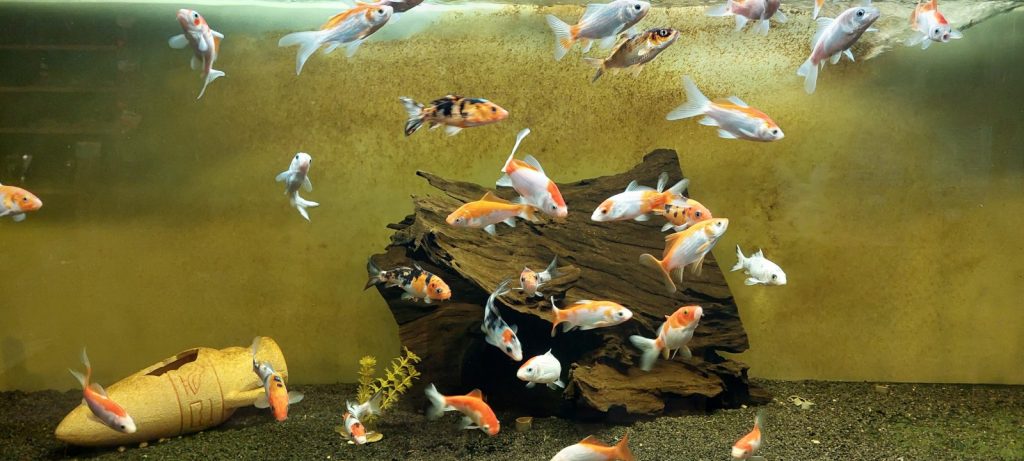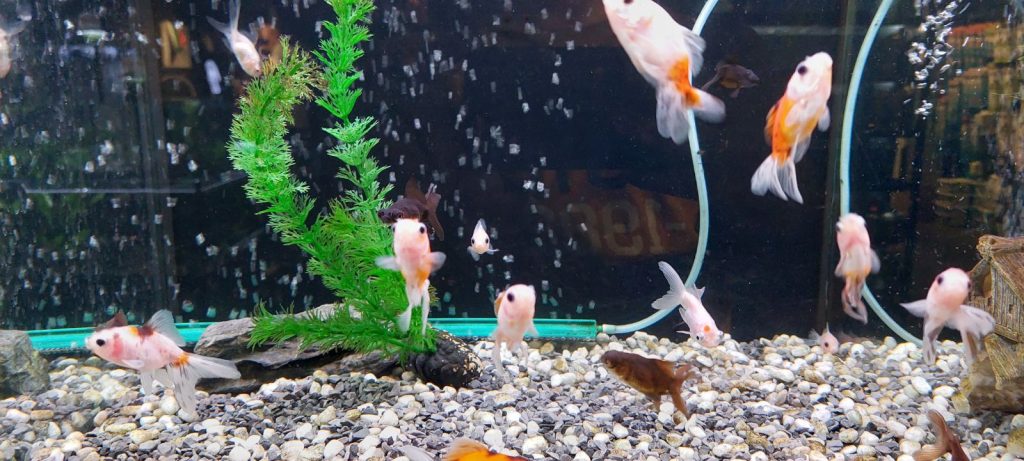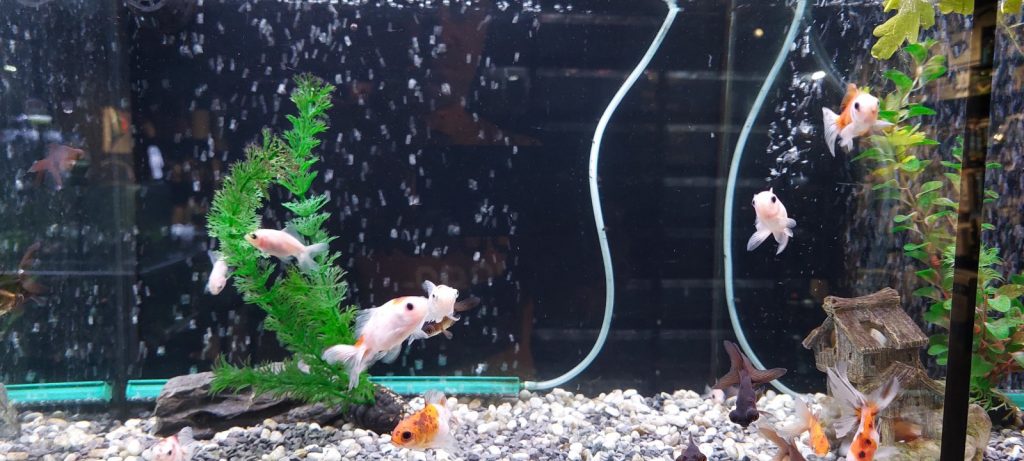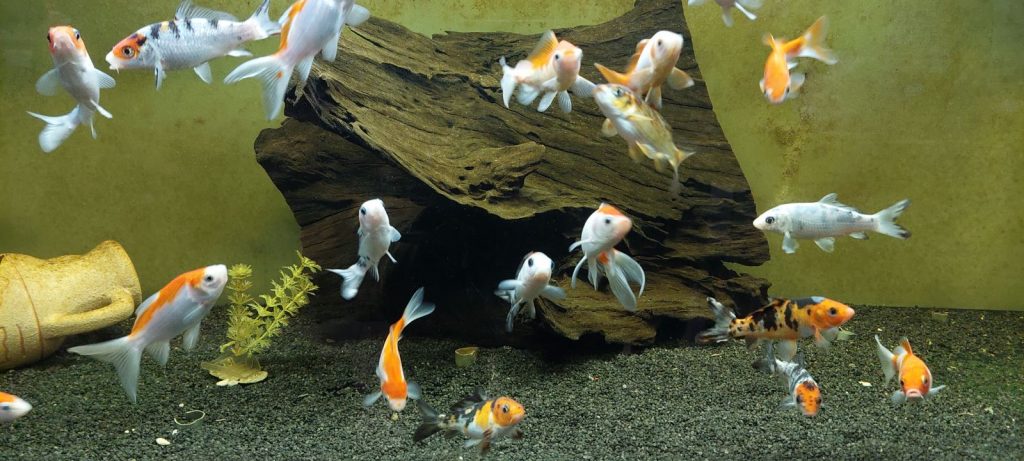
Goldfish appearance
Goldfish are undoubtedly one of the best-known and most commonly kept fish species in aquarium keeping. Their appearance is extremely diverse, ranging from classic gold-colored specimens to unique breeding variants with amazing features. Here we take a thorough look at the fascinating appearance of these popular aquarium inhabitants.
Basic color and pattern:
The base color of most goldfish is a striking gold or orange, from which they derive their name. However, this color can vary depending on the breeding variant and individual characteristics. Some Carassius auratus come in bright red, yellow, white or silver. In addition to the basic color, goldfish are often decorated with various patterns. These include stripes, spots, scales and other distinctive markings.
Body shape and tail fins:
Goldfish are known for their different body shapes and caudal fins, which contribute to their visual diversity:
Single caudal fin:
These fish have a single long fin on their back known as the dorsal fin. Their body shape is usually slim and elegant.
Veiltail Goldfish:
These fish have long, intricate fins and a thick, billowing tail that looks like a veil. This variant gives them a majestic look.
Eyes and scales:
Goldfish’s eyes are often large, round and expressive. They give the fish character and tempting looks. Goldfish’s scales are usually smooth and shiny, and they can be arranged differently depending on color variations and breeding varieties.
Height and growth:
Depending on how they are kept and fed, goldfish can grow quite large. In a suitable habitat they can reach between 15 and 30 centimeters or even more. Their growth is slow and can take years.
Color intensity and health:
The color intensity of goldfish depends on various factors, including their genetics, their diet and the quality of their care. Healthy Carassius auratus have bright colors and shiny scales.
Goldfish, Carassius auratus: origin, homeland and distribution
These fascinating fish have a rich history that is closely linked to their origins, native habitat and global distribution. In this comprehensive article, we take an in-depth look at the origin, homeland and distribution of the goldfish.
The origin of the goldfish:
The origins of goldfish can be traced back to ancient China, where they were first bred over a thousand years ago. They were originally bred from wild fish native to rivers and ponds in East Asia, particularly China, Japan and Korea. These wild fish, known as silver crucian carp or silver carp (Carassius gibelio), formed the genetic basis for the first goldfish breeds.
The home of the goldfish:
The original homeland of goldfish is East Asia, especially China, where they were found in the rivers and ponds. It is believed that the first farmed goldfish appeared in China during the Tang Dynasty (618-907 AD). These fish quickly became sought-after status symbols due to their colorful mutations and peaceful behavior and were kept in wealthy Chinese households.
The distribution of the goldfish:
The spread of goldfish outside of China and Asia began in the 17th century when they were first brought to Europe. During the Ming Dynasty (1368-1644), they were kept in Chinese gardens for their decorative colors and shapes, and some specimens were given as gifts to European explorers and diplomats. The Carassius auratus eventually reached Europe and was first kept in the Netherlands and later in other European countries.
Over time, various breeding variants of Carassius auratus developed, resulting in an astonishing variety of colors, shapes and characteristics. This diversity contributed to the goldfish’s worldwide popularity as an ornamental fish.
The global spread of the goldfish led to:
Popularity in Aquariums: Goldfish are now found in aquariums around the world and were among the first fish that aquarists kept in their home aquariums.
Keeping in garden ponds: The Carassius auratus is a common resident of garden ponds and is often valued for its beauty and its ability to provide natural pest control.
Research and Education: Goldfish are the subject of scientific research into genetics and evolution. They are also used in educational institutions to demonstrate principles of heredity and biology.
Symbolism: Goldfish are symbols of luck, prosperity and endurance in many cultures around the world. They are also present in art and literature.
The Carassius auratus has a fascinating history, closely linked to its origin in China, its home in East Asian waters and its global distribution. The diversity of goldfish breeding varieties and their cultural significance make them one of the most valued and iconic fish species around the world.
The different types of goldfish
Goldfish (Carassius auratus) are known in aquariums and garden ponds for their variety of colors and shapes. Over the centuries, various goldfish species and breeding variants have been developed. Here are some of the most famous and fascinating goldfish species:
- Single fins:
This is the original form of the goldfish with a single caudal fin on its back.
They are often golden yellow, but can also come in other colors such as red, white, black and orange.
Single fins have a slim, elegant body shape.
- Veil tail:
Veiltail goldfish are known for their long, intricate fins and thick, billowing tail.
They come in different colors and can be both monochromatic and multi-colored.
Due to their majestic appearance, they are popular ornamental fish.
- Ryukin:
Ryukin goldfish have a compact body shape with a high back.
Their fins are often short and wavy.
They come in a variety of colors including red, white, orange and black.
- Telescope:
Telescopic goldfish are characterized by their protruding eyes, which look like telescopic scopes.
They have a smooth, rounded body shape and short fins.
The colors vary from gold to white to black.
- Veiltail:
Veiltail goldfish have long, wavy fins that look like veils.
Their body shape is often similar to that of a solitary fin.
Colors can range from red to orange to white.
- Celestial Eye:
These goldfish are known for their prominent, heavenly-looking eyes.
Their body shape is similar to that of a solitary fin.
Celestial Eyes are often available in different colors.
- Pompon:
Pompon goldfish are characterized by small, hair-like growths on their nostrils that look like pompoms.
Their body shape is often compact, similar to that of a Ryukin.
They are available in different colors.
- Pearl scales:
Pearl scale goldfish have scales that look like pearls and they are often shiny metallic in color.
They can come in a variety of body shapes, including single-finned and veil-tailed.
- Panda Moor:
These striking goldfish have a black and white contrast reminiscent of a panda.
Their body shape can vary, ranging from single-finned to veil-tailed.
The goldfish species and breeding varieties mentioned above are just a selection of the diversity that these fascinating fish offer. Each species has its own unique characteristics and aesthetic appeal, making them popular ornamental fish in aquariums and garden ponds around the world.


Goldfish breeding
Breeding goldfish (Carassius auratus) can be a fascinating and rewarding experience. Here are the basic steps and considerations for successfully breeding goldfish:
- Choice of breeding pairs:
To start breeding, you need to select suitable breeding pairs. Healthy, mature Carassius auratus that are in good shape and show no signs of illness or injury are ideal.
Note that breeding between different goldfish species can result in hybrid offspring whose characteristics vary.
- Gender distinction:
To distinguish the sexes, you should pay attention to the following features:
Males: Male goldfish often have smaller, slimmer bodies and more pronounced gill coverings. They also develop tiny white dots (tubercules) on their gill covers and fins during the breeding season.
Females: Female goldfish tend to be fuller, rounder, and have stronger abdomens, especially during spawning season.
- Prepare to spawn:
To prepare the fish for spawning, you should slightly increase the water temperature (to around 20-24°C) and extend the length of daylight. This simulates spring and stimulates the fish’s willingness to reproduce.
- Prepare spawning medium:
Goldfish lay their eggs on suitable surfaces. You can use a spawning mat made from plant material or an artificial spawning mop to encourage egg laying.
- Observation of spawning behavior:
Observe the behavior of your farmed fish. When the females are ready, they will lay eggs and the males will attempt to fertilize them. The eggs stick to the chosen surface.
- Remove the parents:
After laying eggs, the parents should be removed from the spawning tank as they could eat the eggs or fry.
- Caring for the young fish:
After a few days, the young fish hatch from the eggs. During this phase they are very sensitive and require special care. You can use special fry food or finely ground food to ensure they get enough nutrition.
Frequent water changes are crucial to maintaining water quality for the sensitive young fish.
- Growth and selection:
The fry will grow quickly and may need to be selected for size or traits depending on whether you have specific breeding goals.
- Separation of the sexes:
As the fry grow, you may need to separate them by gender to prevent uncontrolled reproduction.
Breeding goldfish requires time, patience, and careful monitoring of water quality and fish behavior. It is important to ensure that both breeding parents and fry receive the best possible care to ensure healthy and robust offspring.
Goldfish Health and Care
Fish have always been fascinating companions in our aquariums and garden ponds. With their dazzling appearance and calming swimming behavior, they are often the stars of these underwater worlds. In this article, we will take an in-depth look at the health and care of these valuable members of our aquatic community.
- The right home:
Whether you keep your underwater friends in an aquarium or a garden pond, the right home is crucial to their well-being. An aquarium should be large enough to provide enough space for swimming and growing. In a garden pond, size and depth are also important as they stabilize the water temperature and provide enough oxygen.
- Water quality and parameters:
The quality of the water your fish live in is of utmost importance. Regular water changes are necessary to remove pollutants and maintain water quality. Regularly check water parameters such as pH, ammonia, nitrite and nitrate levels to ensure they are within the optimal range.
- Nutrition and feeding:
Proper nutrition is an essential part of goldfish care. A balanced diet consisting of high-quality fish food, live or frozen food, and vegetables ensures optimal health. Be careful not to overfeed as excess food can affect water quality.
- Health check:
Monitor your fish regularly for signs of illness or stress. Common signs of health problems include changes in swimming behavior, skin or fin changes, fin clamping, excessive mucus, or signs of parasites. In the event of any abnormalities, you should act immediately and, if necessary, consult a fish veterinarian.
- Social needs:
Goldfish are social creatures and feel most comfortable in company. It is recommended to keep them in small groups to avoid isolation and stress. Make sure the group is gender balanced.
- Environmental enrichment:
Provide your fish with hiding places such as plants or hiding places to provide refuge and protection. Toys and decorations can also make the environment more interesting.
- Responsible breeding:
If you decide to breed, do so responsibly. Raising and caring for fry requires special attention and a controlled environment.
- Temperature control:
Goldfish are cold-water loving fish and prefer temperatures between 18 and 22 degrees Celsius. Excessive heat or cold can affect their health.
The health and care of these graceful underwater creatures requires commitment and care. By providing suitable habitat, maintaining good water quality and a balanced diet, you can ensure that your fish can live a happy and fulfilling life. This is an act of affection and responsibility towards these wonderful creatures that liven up our aquariums and garden ponds.
Nutrition of Carassius auratus in nature and aquarium
The diet of Carassius auratus, commonly known as goldfish, differs depending on its habitat in nature and in an aquarium. Here are the main differences and similarities in their diet:
Nutrition in nature:
In nature, goldfish are omnivores and have a diverse diet. Their natural habitat is stagnant or slow-flowing water such as ponds, lakes and rivers. Your diet includes:
Plant food: Carassius auratus eat a variety of aquatic plants, including algae, duckweed, watercress and other aquatic plants.
Small invertebrates: They feed on insect larvae, worms, snails and other small invertebrates that they find in the water.
Plankton and small animals: Carassius auratus also consume plankton, tiny crustaceans and larvae of aquatic insects.
Detritus: Detritus consists of dead plant parts and organic material that floats in the water. Goldfish also eat detritus.
Nutrition in the aquarium:
In an aquarium, Carassius auratus must receive a balanced diet that meets their nutritional needs. The diet in the aquarium includes:
High-quality fish food: Commercial fish food, whether in the form of flakes, pellets or granules, is an important source of all necessary nutrients. There are special goldfish foods on the market tailored to their needs.
Live or frozen food: Live or frozen food such as mosquito larvae, daphnia, water fleas and bloodworms can be offered from time to time to enrich their diet.
Vegetables: These fish also like vegetables such as peas, lettuce leaves and cucumbers. These can be offered raw or lightly cooked and peeled.
Duckweed or aquatic plants: Some aquatic plants that grow in the aquarium, such as water lettuce or duckweed, can also serve as food.
Variation: A varied diet is important to ensure the goldfish receive all the necessary nutrients. It is recommended to vary the diet to ensure they are getting a balanced diet.
It is important not to overfeed Carassius auratus as this can lead to water contamination. Feed them in small portions and see how much they eat within a few minutes. Uneaten food should be removed to maintain water quality.
Goldfish diets can be adjusted depending on their needs and habitat. A balanced diet is crucial to their health and well-being, whether they live in nature or in an aquarium.

The meaning of goldfish and their appearance in literature
Carassius auratus has acquired symbolic meanings and associations in various cultures and contexts. Here are some of the most common meanings and interpretations of the Carassius auratus:
- Good Luck and Prosperity: In many cultures, the goldfish is viewed as a symbol of good luck and prosperity. Due to its golden color and magnificent appearance, it is often associated with wealth and success.
- Endurance and Longevity: Carassius auratus have the ability to live for long periods of time if properly cared for. Therefore, they are sometimes considered a symbol of endurance and longevity. In Chinese culture, they represent the pursuit of a long and fulfilling life.
- Transformation and transformation: The Carassius auratus can also be seen as a symbol of transformation and metamorphosis. This goes back to the legends in which simple carp swim through a waterfall and transform into magnificent goldfish.
- Freedom and Independence: Due to their ability to survive in various bodies of water and often kept in garden ponds or aquariums, goldfish are sometimes interpreted as a symbol of freedom and independence.
- Spiritual Meaning: In some spiritual or esoteric teachings, the Carassius auratus is considered a symbol of enlightenment and spiritual awakening. This is based on the idea that the goldfish has a connection to the spiritual world due to its colors and behavior.
- Greed and Materialism: In some stories and fairy tales, the Carassius auratus is used as a warning against greed and materialism. This is often accompanied by stories in which the desire for wealth or power through interaction with a goldfish has negative consequences.
The meaning of the goldfish can vary depending on cultural background and personal interpretation. In many cases the goldfish is seen as a positive symbol of good luck, wealth and prosperity, while in other contexts it serves as a symbol of deeper philosophical or spiritual concepts.
Goldfish have achieved some prominence in literature and the cultural imagination and have been depicted in different ways in various works. Here are some examples of their representation in literature and culture:
- “The Goldfish” by Arthur Schnitzler:
In this novella by Arthur Schnitzler, a Carassius auratus plays a symbolic role. The protagonist, a young man, finds himself fascinated by a goldfish in an aquarium and sees it as a metaphor for his own limited existence. The work explores themes such as isolation and longing.
- “The Golden Fish” in Russian fairy tales:
In Russian folklore there are stories about a magical “golden fish” that grants a fisherman three wishes. These fairy tales often emphasize the moral lesson that greed and ingratitude lead to negative consequences.
- “Finding Nemo” (film):
The Pixar animated film Finding Nemo features a character named Bubbles, a gold-colored puffer fish. Although it is not exactly a goldfish, it symbolizes the charm and beauty of goldfish. The film tells the story of Nemo, a clownfish who escapes from an aquarium and goes on an adventure.
- “The Carp Piper” in Chinese literature:
In Chinese literature and culture, the Carassius auratus is often associated with legends about the “carp piper”. These stories tell of a man who, by playing a piper, gains the ability to turn goldfish into valuable jewels.
- “The Adventures of King Mammoth Eye” by Gottfried Keller:
This story by Gottfried Keller contains a passage about a Carassius auratus held by a young woman named Fanny. The fish is used as a symbol of the innocent joy of life and contrasts with the worried nature of the protagonist.
In literature, goldfish are often symbols for various themes such as freedom, longing, beauty or the transience of life. Their magnificent colors and fascinating behavior have inspired writers and artists to portray their significance in a variety of ways.
Disclaimer
The information, content and tools provided on the yabaaa.com website are for informational purposes only. We endeavor to provide accurate and up-to-date information, but we cannot guarantee the accuracy, completeness or timeliness of the content provided.
Use of the information, content and tools on yabaaa.com is at your own risk. We accept no responsibility for any loss, damage or legal consequences arising from the use of the information provided.
Please note that the information provided is general in nature and should not be construed as legal, financial or professional advice. Before making any decision or taking any action based on the information provided on yabaaa.com, we recommend that you consult with qualified professionals to evaluate your particular situation.
Please note that yabaaa.com may contain links to external websites or resources over which we have no control. We are not responsible for the content, privacy practices, or security of such external websites or resources. Access to and use of these external links is at your own risk.
We cannot guarantee that yabaaa.com will always be error-free, uninterrupted, or virus-free. We do not accept any responsibility for any damages that may be caused by such technical problems or viruses. It is your responsibility to take adequate security precautions and use virus protection programs.
The content of yabaaa.com is subject to change without prior notice. We reserve the right at any time and at our discretion to update, change or remove any content on the Website.
By using yabaaa.com you agree to the above terms and disclaimer.
Please also read our privacy policy to understand how we process your personal data.
If you have any questions or concerns, you can contact us using the contact details provided on yabaaa.com.
Thank you for visiting yabaaa.com.